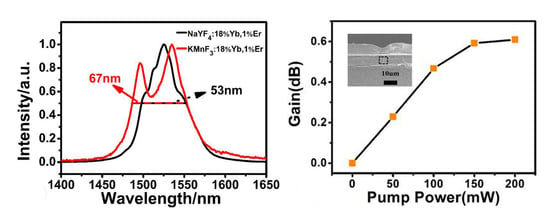KMnF3:Yb3+,Er3+ Core-Active-Shell Nanoparticles with Broadband Down-Shifting Luminescence at 1.5 μm for Polymer-Based Waveguide Amplifiers
Abstract
:1. Introduction
- (1)
- We prepared KMnF3:18%Yb3+,1%Er3+ NPs with a broadband 1.5-μm emission. Its full-width at half-maximum (FWHM) was about 290 cm−1 and was 55 cm−1 wider than that of NaYF4:18%Yb3+,1% NPs with the same size and phase.
- (2)
- We obtained KMnF3:18%Yb3+,1%Er3+@KMnF3:2%Yb3+ core-active-shell NPs with the strong and broadband 1.5-μm emission by coating a KMnF3:2%Yb3+ shell.
2. Experimental
2.1. Chemicals
2.2. Synthetic Procedures
2.3. Characterization
3. Results and Discussion
3.1. Crystal Structure and Morphology
3.2. Down-Shifting Luminescence Properties
3.3. Optical Waveguide Amplifiers Based on KMnF3:18%Yb3+,1%Er3+@KMnF3:2%Yb3+ NPs
4. Conclusions
Supplementary Materials
Author Contributions
Funding
Conflicts of Interest
References
- Zhang, M.L.; Zhang, W.W.; Wang, F.; Zhao, D.; Qu, C.Y.; Wang, X.B.; Yi, Y.J.; Cassan, E.; Zhang, D.M. High-gain polymer optical waveguide amplifiers based on core-shell NaYF4/NaLuF4:Yb3+,Er3+ NPs-PMMA covalent-linking nanocomposites. Sci. Rep. 2016, 6, 36729. [Google Scholar] [CrossRef] [PubMed]
- Ghosh, R.N.; Shmulovich, J.; Kane, C.F.; Barros, M.R.D. 8-mW threshold Er3+-doped planar waveguide amplifier. IEEE Photonics Technol. Lett. 2016, 8, 518–520. [Google Scholar] [CrossRef]
- Sergio, A.; Vázquez, C.; Dijkstra, M.; Bernhardi, E.H.; Ay, F.; Pollnau, M. Erbium-doped spiral amplifiers with 20 dB of net gain on silicon. Opt. Express 2014, 22, 25993–26004. [Google Scholar] [CrossRef]
- Bo, S.; Wang, J.; Zhao, H.; Ren, H.; Wang, Q.; Xu, G.; Zhang, X.; Liu, X.; Zhen, Z. LaF3:Er,Yb doped sol-gel polymeric optical waveguide amplifiers. Appl. Phys. B 2008, 91, 79–83. [Google Scholar] [CrossRef]
- Zhang, D.; Chen, C.; Chen, C.M.; Ma, C.S.; Zhang, D.M.; Bo, S.H.; Zhen, Z. Optical gain at 1535 nm in LaF3:Er,Yb nanoparticle-doped organic-inorganic hybrid material waveguide. Appl. Phys. Lett. 2007, 91, 161109. [Google Scholar] [CrossRef]
- Ye, H.Q.; Li, Z.; Peng, Y.; Wang, C.C.; Li, T.Y.; Zheng, Y.X.; Sapelkin, A.; Adamopoulos, G.; Hernández, I.; Wyatt, P.B.; et al. Organo-erbium systems for optical amplification at telecommunications wavelengths. Nat. Mater. 2014, 13, 382–386. [Google Scholar] [CrossRef]
- Wong, W.H.; Chan, K.S.; Pun, E.Y.B. Ultraviolet direct printing of rare-earth-doped polymer waveguide amplifiers. Appl. Phys. Lett. 2005, 87, 011103. [Google Scholar] [CrossRef]
- Wang, T.J.; Zhao, D.; Zhang, M.L.; Yin, J.; Song, W.Y.; Jia, Z.X.; Wang, X.B.; Qin, G.S.; Qin, W.P.; Wang, F.; et al. Optical waveguide amplifiers based on NaYF4:Er3+,Yb3+ NPs-PMMA covalent-linking nanocomposites. Opt. Mater. Express 2015, 5, 469–477. [Google Scholar] [CrossRef]
- Shen, X.; Wang, Y.; Guo, H.; Liu, C. Near-infrared carbon-implanted Er3+/Yb3+ co-doped phosphate glass waveguides. Front. Optoelectron. 2018, 11, 291–295. [Google Scholar] [CrossRef]
- Chen, C.; He, R.; Tan, Y.; Wang, B. Optical ridge waveguides in Er3+/Yb3+ co-doped phosphate glass produced by ion irradiation combined with femtosecond laser ablation for guided-wave green and red upconversion emissions. Opt. Mater. 2016, 51, 185–189. [Google Scholar] [CrossRef]
- Zhu, Q.F.; Shen, X.L.; Zheng, R.L.; Lv, P.; Guo, H.T.; Li, W.N.; Liu, C.X. Waveguiding structures in Yb3+-doped phosphate glasses by double-energy proton and single-energy carbon-ion implantations. Mater. Res. Express 2018, 5, 016404. [Google Scholar] [CrossRef]
- Khu, V.; Steve, M. Tellurium dioxide Erbium doped planar rib waveguide amplifiers with net gain and 2.8dB/cm internal gain. Opt. Express 2010, 18, 19192–19200. [Google Scholar] [CrossRef]
- Avram, D.; Tiseanu, I.; Vasile, B.S.; Florea, M.; Tiseanu, C. Near infrared emission properties of Er doped cubic sesquioxides in the second/third biological windows. Sci. Rep. 2018, 8, 18033. [Google Scholar] [CrossRef]
- Bradley, J.D.B.; Silva, M.C.; Gay, M.; Bramerie, L.; Driessen, A.; Wörhoff, K.; Simon, J.C.; Pollnau, M. 170 Gbit/s transmission in an erbium-doped waveguide amplifier on silicon. Opt. Express 2009, 17, 22201–22208. [Google Scholar] [CrossRef]
- Bo, S.H.; Hu, J.; Chen, Z.; Wang, Q.; Xu, G.M.; Liu, X.H.; Zhen, Z. Core-shell LaF3:Er,Yb nanocrystal doped sol–gel materials as waveguide amplifiers. Appl. Phys. B 2009, 97, 665–669. [Google Scholar] [CrossRef]
- Kumar, G.A.; Chen, C.W.; Ballato, J.; Riman, R.E. Optical Characterization of Infrared Emitting Rare-Earth-Doped Fluoride Nanocrystals and Their Transparent Nanocomposites. Chem. Mater. 2007, 19, 1523–1528. [Google Scholar] [CrossRef]
- Lei, K.L.; Chow, C.F.; Tsang, K.C.; Lei, E.N.Y.; Roy, V.A.L.; Lam, M.H.W.; Lee, C.S.; Pun, E.Y.B.; Li, J. Long aliphatic chain coated rare-earth nanocrystal as polymer-based optical waveguide amplifiers. J. Mater. Chem. 2010, 20, 7526–7529. [Google Scholar] [CrossRef]
- Najar, A.; Lorrain, N.; Ajlani, H.; Charrier, J.; Oueslati, M.; Haji, L. Er3+ doping conditions of planar porous silicon waveguides. Appl. Surf. Sci. 2009, 256, 581–586. [Google Scholar] [CrossRef]
- Wong, W.H.; Pun, E.Y.B.; Chan, K.S. Er3+-Yb3+ codoped polymeric optical waveguide amplifiers. Appl. Phys. Lett. 2004, 84, 176–178. [Google Scholar] [CrossRef]
- Zhai, X.S.; Li, J.; Liu, S.S.; Liu, X.Y. Enhancement of 1.53 μm emission band in NaYF4:Er3+,Yb3+,Ce3+ nanocrystals for polymer-based optical waveguide amplifiers. Opt. Mater. Express 2013, 3, 270–277. [Google Scholar] [CrossRef]
- Wang, Y.; Guo, X.Y.; Liu, S.S.; Zheng, K.Z.; Qin, Z.K.; Qin, W.P. Controllable synthesis of β-NaLuF4:Yb3+,Er3+ nanocrystals and their application in polymer-based optical waveguide amplifiers. J. Fluor. Chem. 2015, 175, 125–128. [Google Scholar] [CrossRef]
- Haase, M.; Schafer, H. Upconverting Nanoparticles. Angew. Chem. Int. Ed. 2011, 50, 5808–5829. [Google Scholar] [CrossRef]
- Liu, Y.; Tu, D.; Zhu, H.; Chen, X. Lanthanide-doped luminescent nanoprobes: Controlled synthesis, optical spectroscopy, and bioapplications. Chem. Soc. Rev. 2013, 42, 6924–6958. [Google Scholar] [CrossRef]
- Zhang, Y.L.; Shi, Y.D.; Qin, Z.K.; Song, M.X.; Qin, W.P. Synthesis of small Ce3+-Er3+-Yb3+ tri-doped BaLuF5 active-core-active-shell-active-shell nanoparticles with strong down conversion luminescence at 1.5 μm. Nanomaterials 2018, 8, 615. [Google Scholar] [CrossRef]
- Khaydukov, K.V.; Rocheva, V.V.; Savelyev, A.G.; Sarycheva, M.E.; Asharchuk, I.M. Synthesis of NaLuF4: Er3+, Yb3+, Ce3+ nanoparticles and study of photoluminescent properties in C-band. EPJ Web Conf. 2017, 132, 03049. [Google Scholar] [CrossRef]
- Chen, G.; Ohulchanskyy, T.Y.; Liu, S.; Law, W.C.; Wu, F.; Swihart, M.T.; Agren, H.; Prasad, P.N. Core/shell NaGdF4:Nd3+/NaGdF4 nanocrystals with efficient near-infrared to near-infrared downconversion photoluminescence for bioimaging applications. J. ACS Nano 2012, 6, 2969–2977. [Google Scholar] [CrossRef]
- Wang, F.; Deng, R.R.; Liu, X.G. Preparation of core-shell NaGdF4 nanoparticles doped with luminescent lanthanide ions to be used as upconversion-based probes. Nat. Protocols 2014, 9, 1634–1644. [Google Scholar] [CrossRef]
- Wang, J.; Wang, F.; Wang, C.; Liu, Z.; Liu, X.G. Single-Band Upconversion Emission in Lanthanide-Doped KMnF3 Nanocrystals. Angew. Chem. Int. Ed. 2011, 50, 10369–10372. [Google Scholar] [CrossRef]
- Zhang, Y.L.; Wang, F.; Lang, Y.B.; Yin, J.; Zhang, M.L.; Liu, X.H.; Zhang, D.M.; Zhao, D.; Qin, G.S.; Qin, W.P. KMnF3:Yb3+,Er3+@KMnF3:Yb3+ active-core–activeshell nanoparticles with enhanced red upconversion fluorescence for polymer-based waveguide amplifiers operating at 650 nm. J. Mater. Chem. C 2015, 3, 9827–9832. [Google Scholar] [CrossRef]
- Zhao, D.; Chen, H.; Zheng, K.Z.; Chuai, X.H.; Yu, F.D.; Li, H.; Wu, C.F.; Qin, G.S.; Di, W.H.; Qin, W.P. Growth of hexagonal phase sodium rare earth tetrafluorides induced by heterogeneous cubic phase core. RSC Adv. 2014, 4, 13490–13494. [Google Scholar] [CrossRef]
- Chen, C.; Zhang, D.; Li, T.; Zhang, D.M.; Song, L.M.; Zhen, Z. Erbium-ytterbium codoped waveguide amplifier fabricated with solutionprocessable complex. Appl. Phys. Lett. 2009, 94, 041119. [Google Scholar] [CrossRef]
- Boyer, J.C.; Gagnon, J.; Cuccia, L.A.; Capobianco, J.A. Synthesis, characterization, and spectroscopy of NaGdF4:Ce3+,Tb3+/NaYF4 core/shell nanoparticles. Chem. Mater. 2007, 19, 3358–3360. [Google Scholar] [CrossRef]
- Lezhnina, M.M.; Jüstel, T.; Kätker, H.; Wiechert, D.U.; Kynast, U.H. Efficient Luminescence from Rare-Earth Fluoride Nanoparticles with Optically Functional Shells. Adv. Funct. Mater. 2006, 16, 935–942. [Google Scholar] [CrossRef]
- Zhang, Y.L.; Liu, X.H.; Lang, Y.B.; Yuan, Z.; Zhao, D.; Qin, G.S.; Qin, W.P. Synthesis of ultra-small BaLuF5:Yb3+,Er3+@BaLuF5:Yb3+ active-core–activeshell nanoparticles with enhanced up-conversion and down-conversion luminescence by a layer-bylayer strategy. J. Mater. Chem. C 2015, 3, 2045–2053. [Google Scholar] [CrossRef]
- Chen, D.Q.; Yu, Y.L.; Huang, F.; Lin, H.; Huang, P.; Yang, A.P.; Wang, Z.X.; Wang, Y.S. Lanthanide dopant-induced formation of uniform sub-10 nm active-core/active-shell nanocrystals with near-infrared to near-infrared dual-modal luminescence. J. Mater. Chem. 2012, 22, 2632–2640. [Google Scholar] [CrossRef]
- Vetrone, F.; Naccache, R.; Mahalingam, V.; Morgan, C.G.; Capobianco, J.A. The active-core/active-shell approach: A Strategy to enhance the upconversion luminescence in lanthanide-doped nanoparticles. Adv. Funct. Mater. 2009, 19, 2924–2929. [Google Scholar] [CrossRef]
- Zhai, X.S.; Liu, S.S.; Liu, X.Y.; Wang, F.; Zhang, D.M.; Qin, G.S.; Qin, W.P. Sub-10 nm BaYF5:Yb3+,Er3+ core-shell nanoparticles with intense 1.53μm fluorescence for polymer-based waveguide amplifiers. J. Mater. Chem. C 2013, 1, 1525–1530. [Google Scholar] [CrossRef]
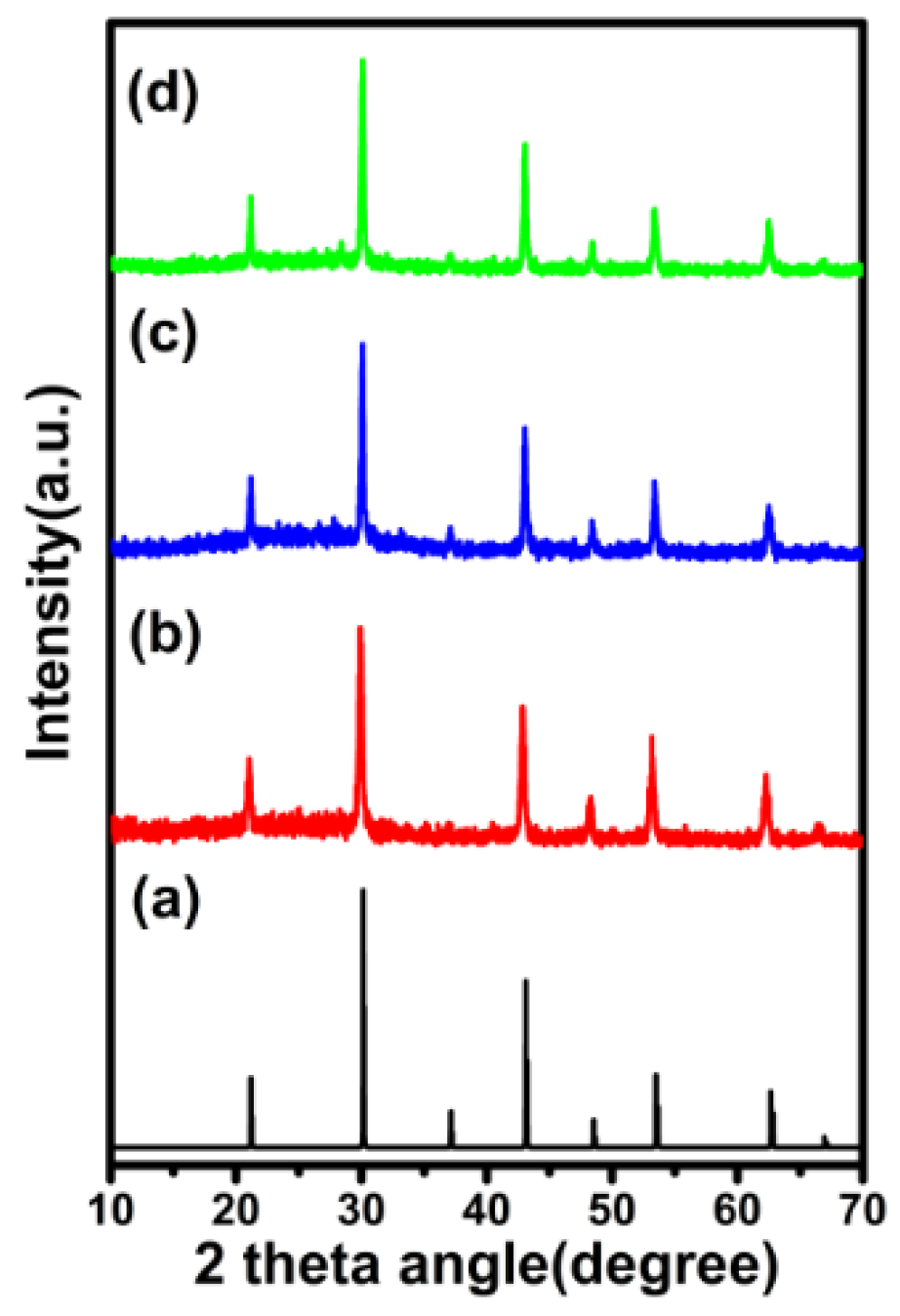
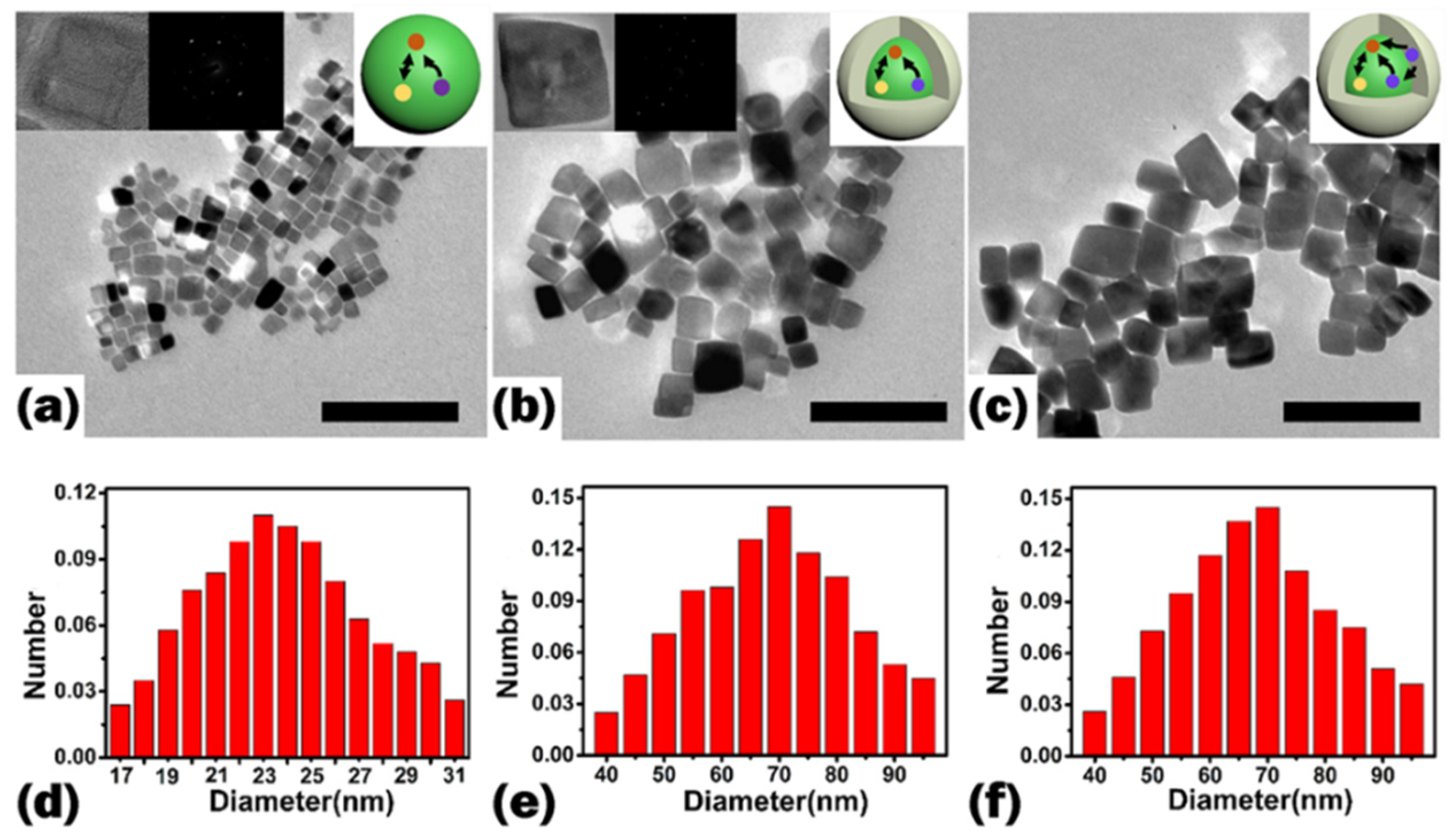
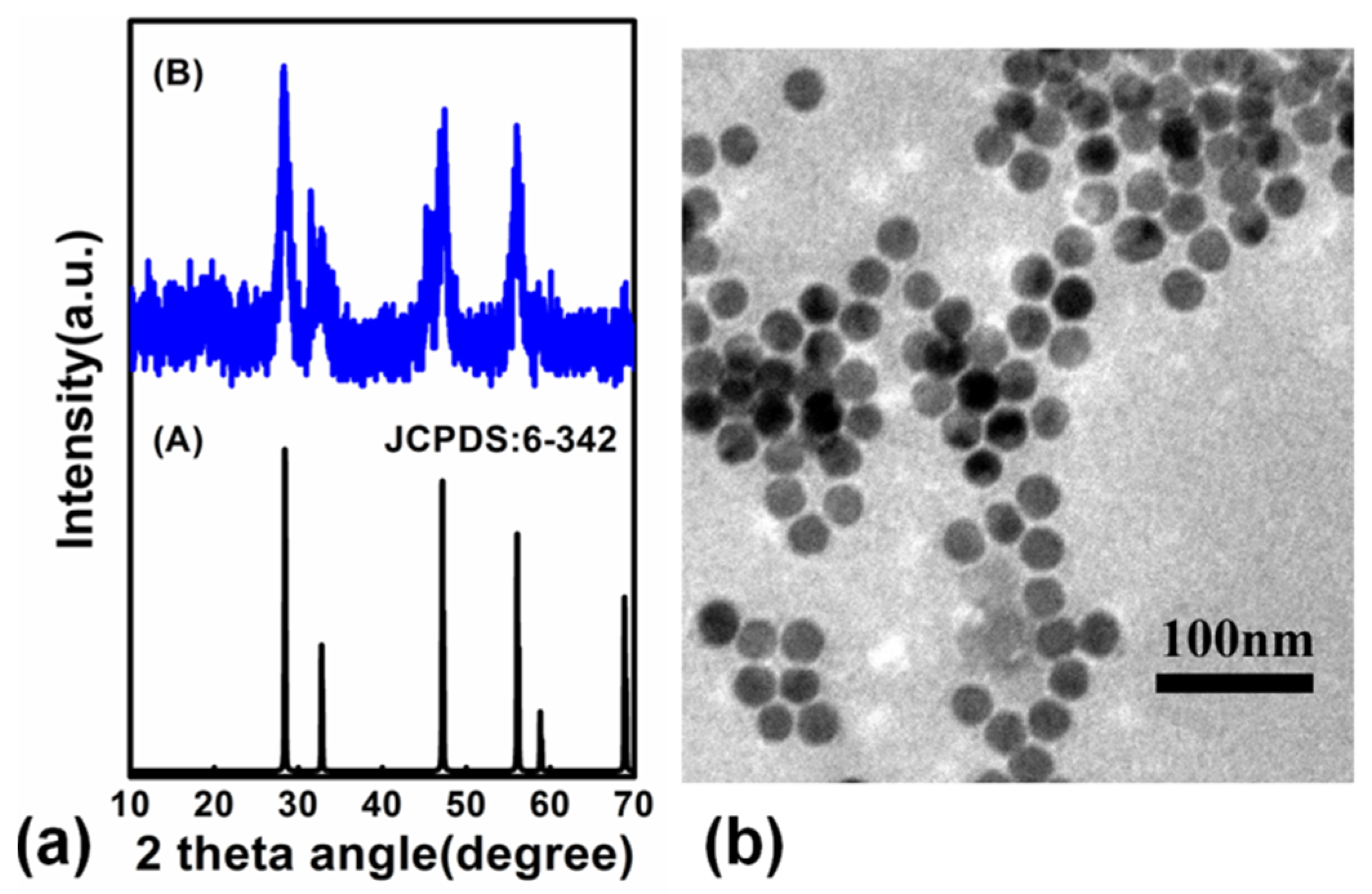
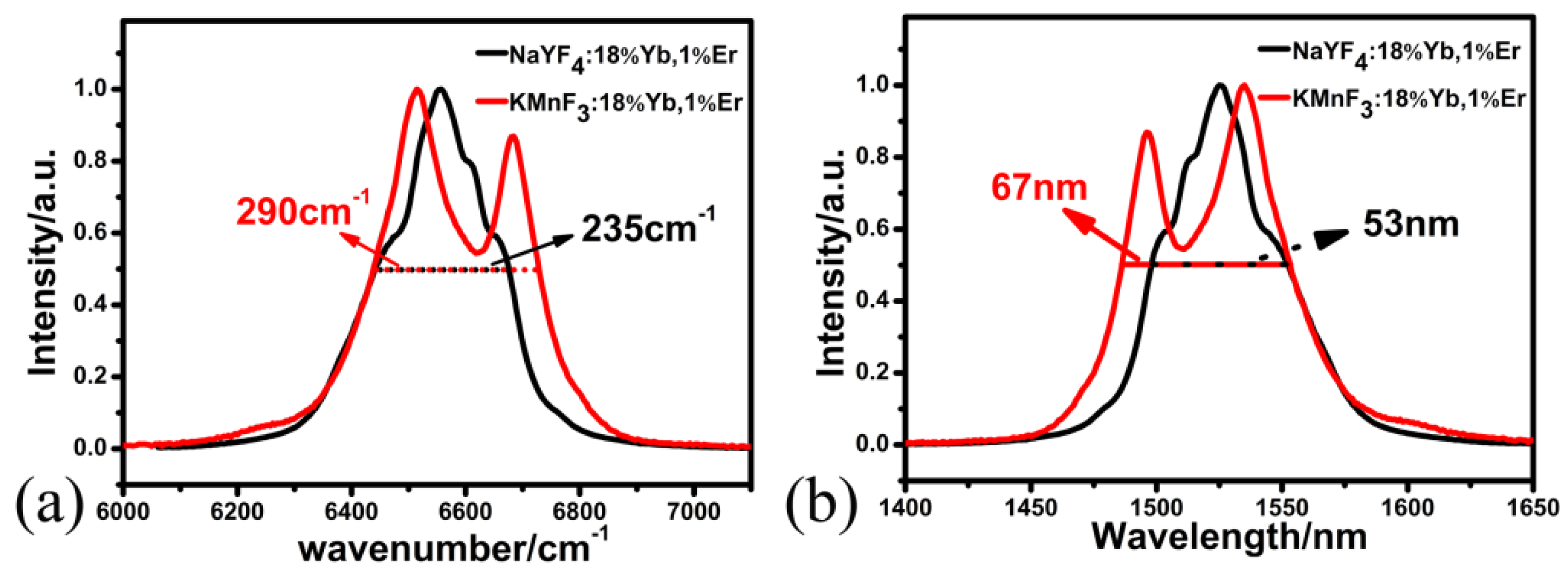
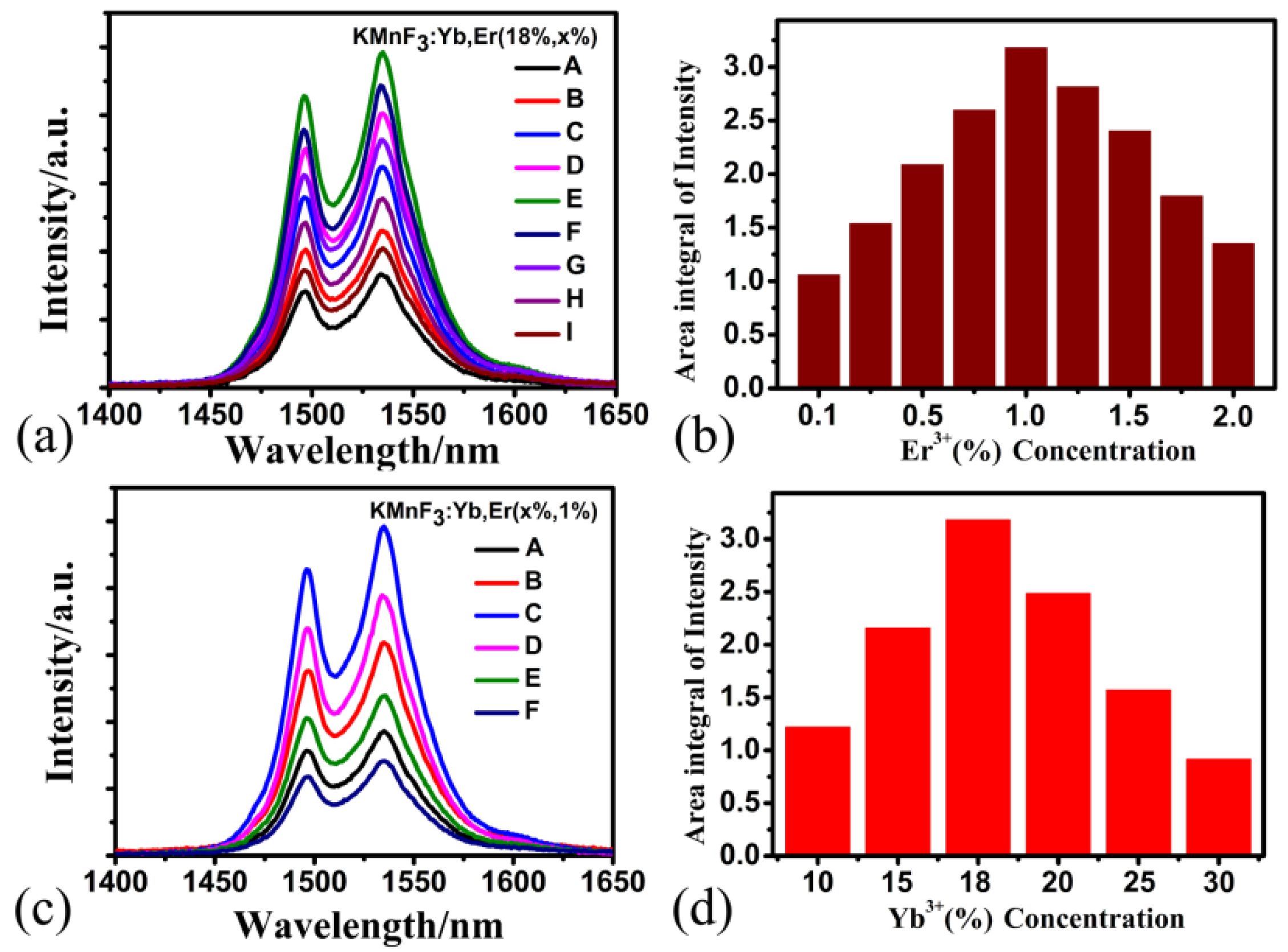
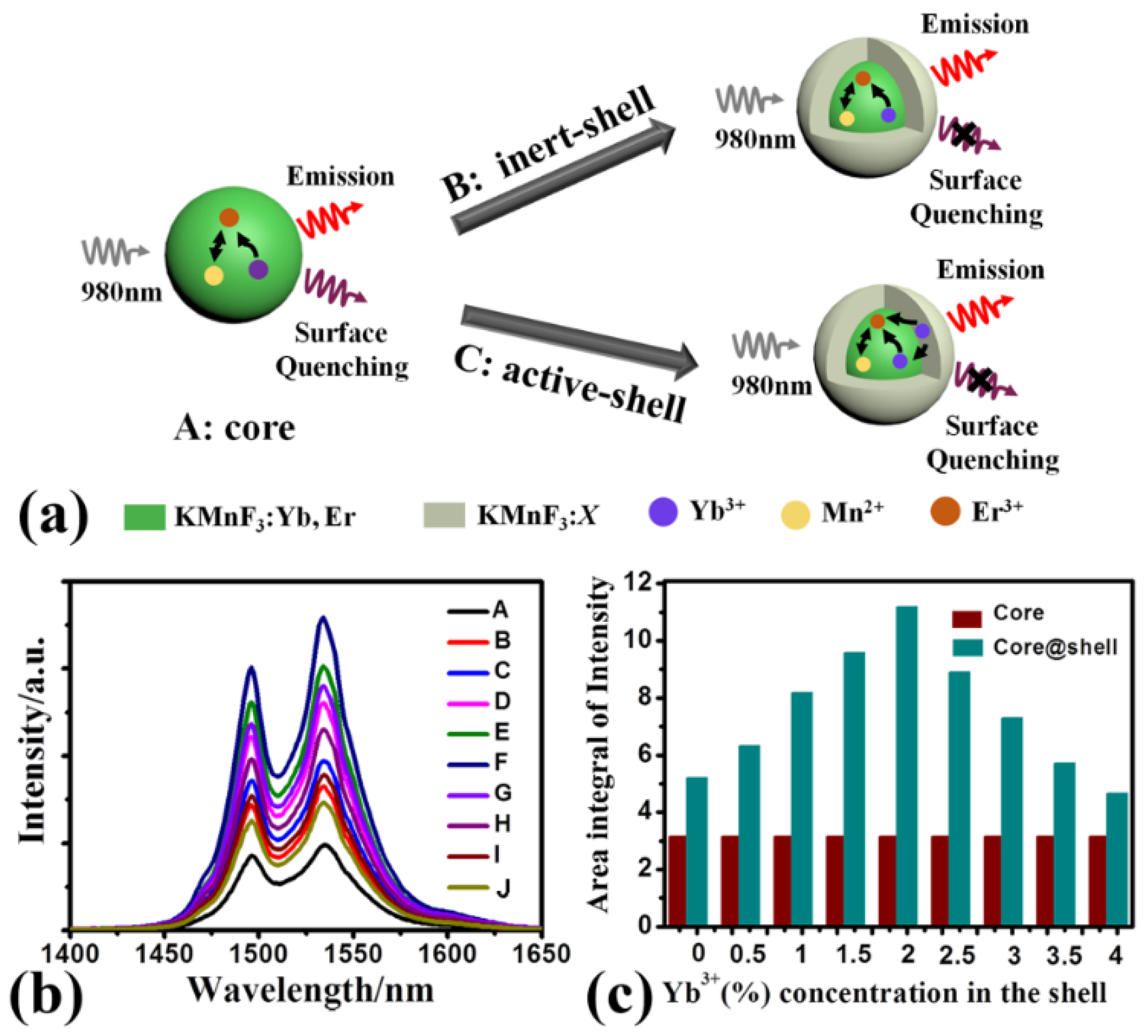
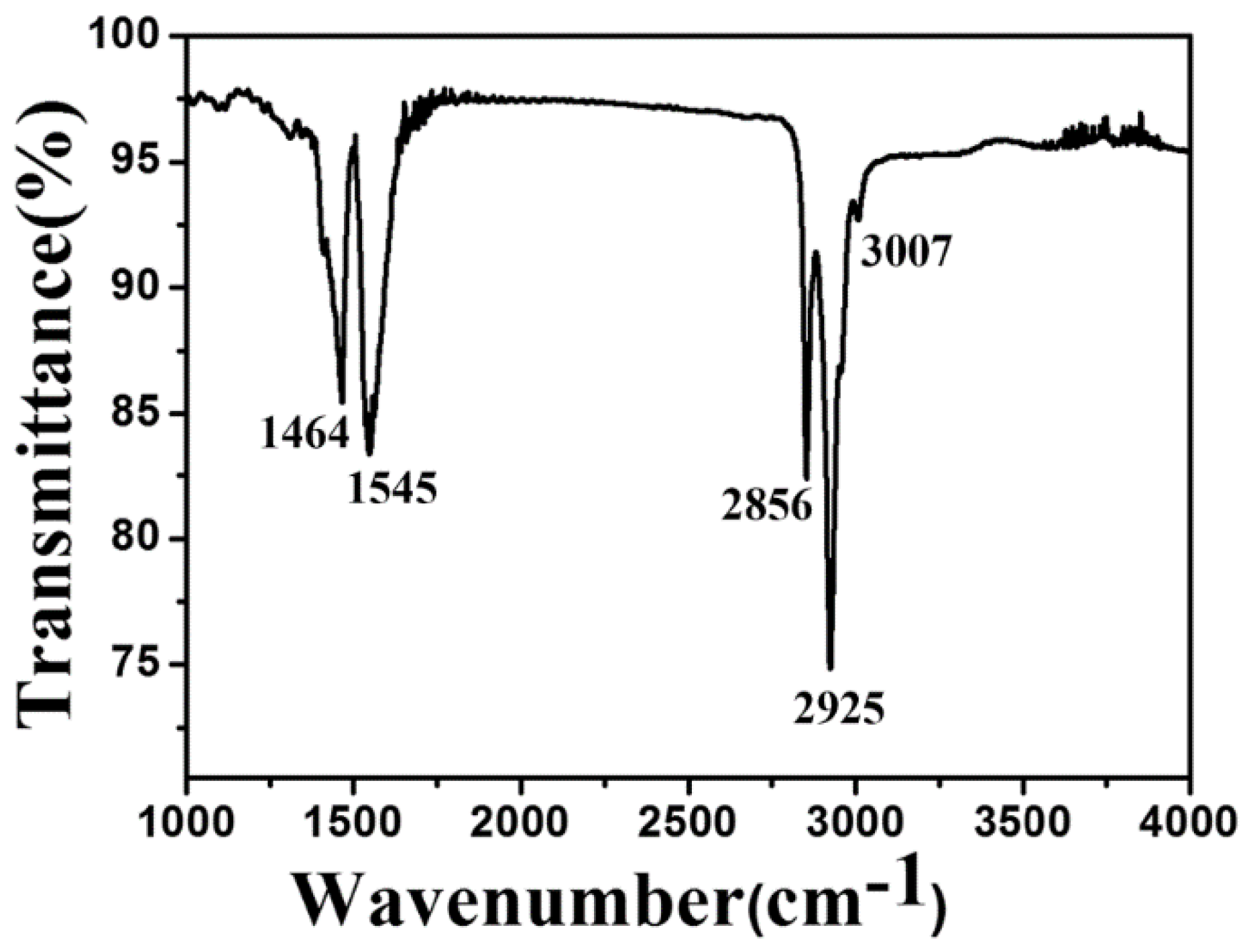
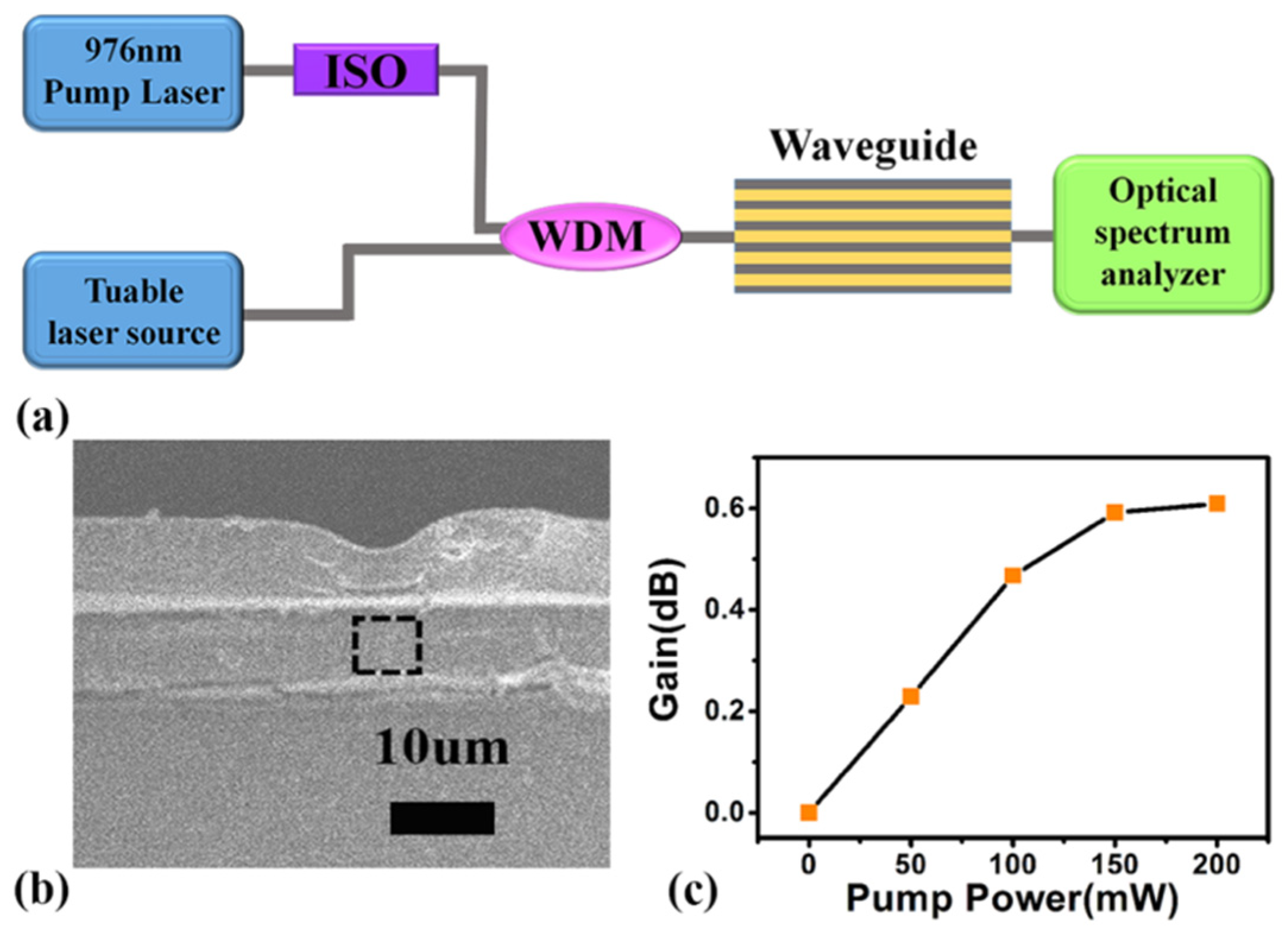
© 2019 by the authors. Licensee MDPI, Basel, Switzerland. This article is an open access article distributed under the terms and conditions of the Creative Commons Attribution (CC BY) license (http://creativecommons.org/licenses/by/4.0/).
Share and Cite
Zhang, Y.; Lv, P.; Wang, D.; Qin, Z.; Wang, F.; Zhang, D.; Zhao, D.; Qin, G.; Qin, W. KMnF3:Yb3+,Er3+ Core-Active-Shell Nanoparticles with Broadband Down-Shifting Luminescence at 1.5 μm for Polymer-Based Waveguide Amplifiers. Nanomaterials 2019, 9, 463. https://doi.org/10.3390/nano9030463
Zhang Y, Lv P, Wang D, Qin Z, Wang F, Zhang D, Zhao D, Qin G, Qin W. KMnF3:Yb3+,Er3+ Core-Active-Shell Nanoparticles with Broadband Down-Shifting Luminescence at 1.5 μm for Polymer-Based Waveguide Amplifiers. Nanomaterials. 2019; 9(3):463. https://doi.org/10.3390/nano9030463
Chicago/Turabian StyleZhang, Yongling, Peng Lv, Dongxia Wang, Zhengkun Qin, Fei Wang, Daming Zhang, Dan Zhao, Guanshi Qin, and Weiping Qin. 2019. "KMnF3:Yb3+,Er3+ Core-Active-Shell Nanoparticles with Broadband Down-Shifting Luminescence at 1.5 μm for Polymer-Based Waveguide Amplifiers" Nanomaterials 9, no. 3: 463. https://doi.org/10.3390/nano9030463
APA StyleZhang, Y., Lv, P., Wang, D., Qin, Z., Wang, F., Zhang, D., Zhao, D., Qin, G., & Qin, W. (2019). KMnF3:Yb3+,Er3+ Core-Active-Shell Nanoparticles with Broadband Down-Shifting Luminescence at 1.5 μm for Polymer-Based Waveguide Amplifiers. Nanomaterials, 9(3), 463. https://doi.org/10.3390/nano9030463




